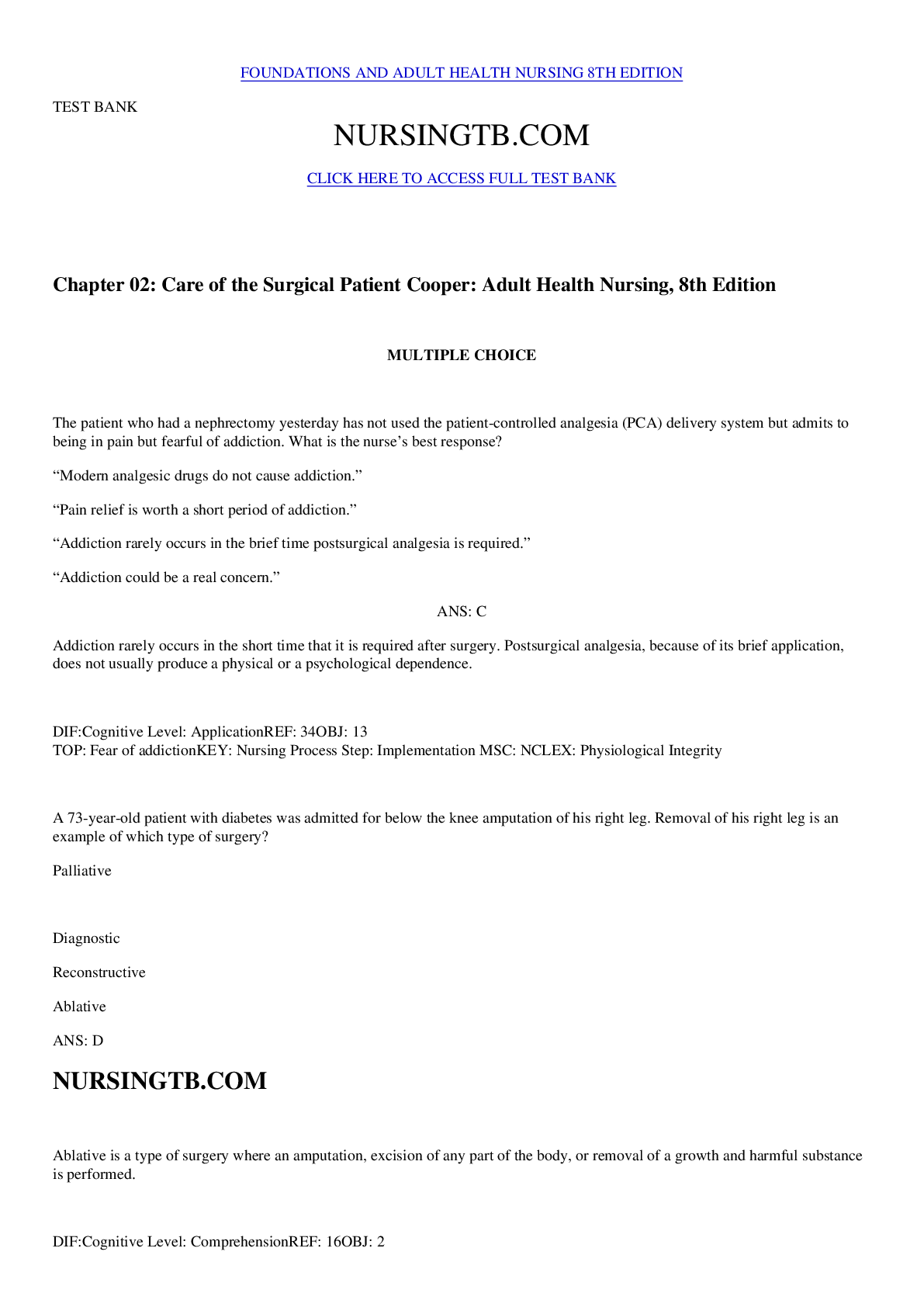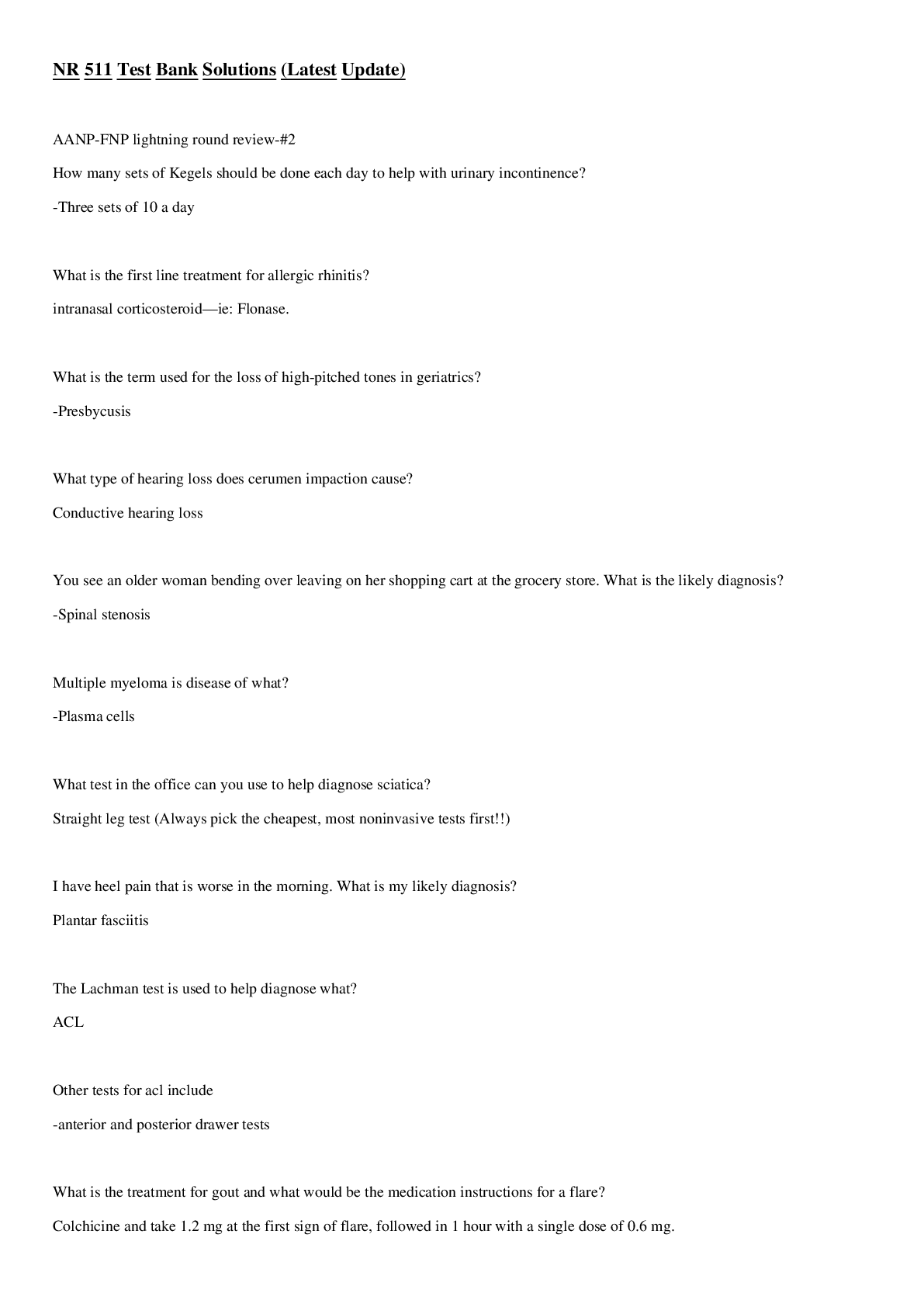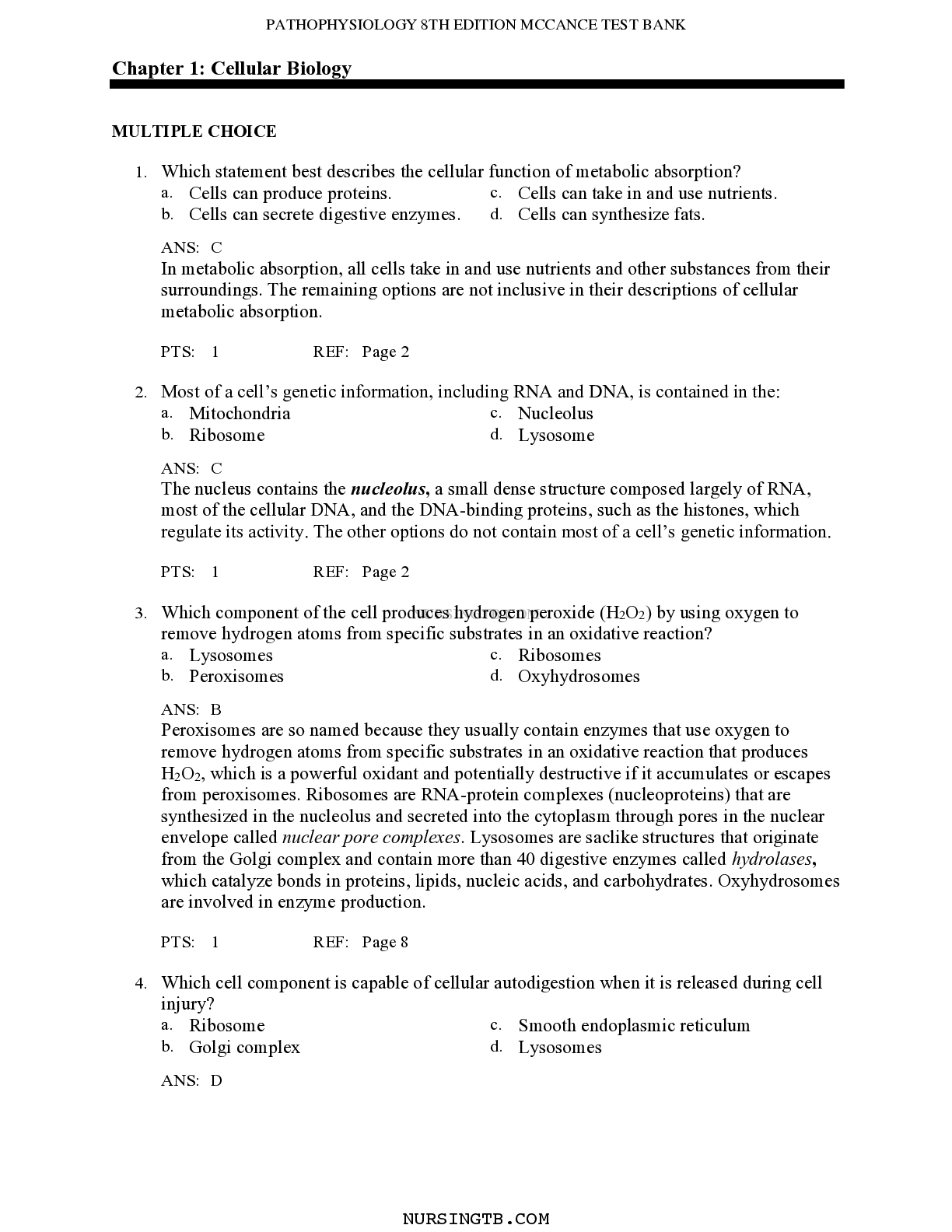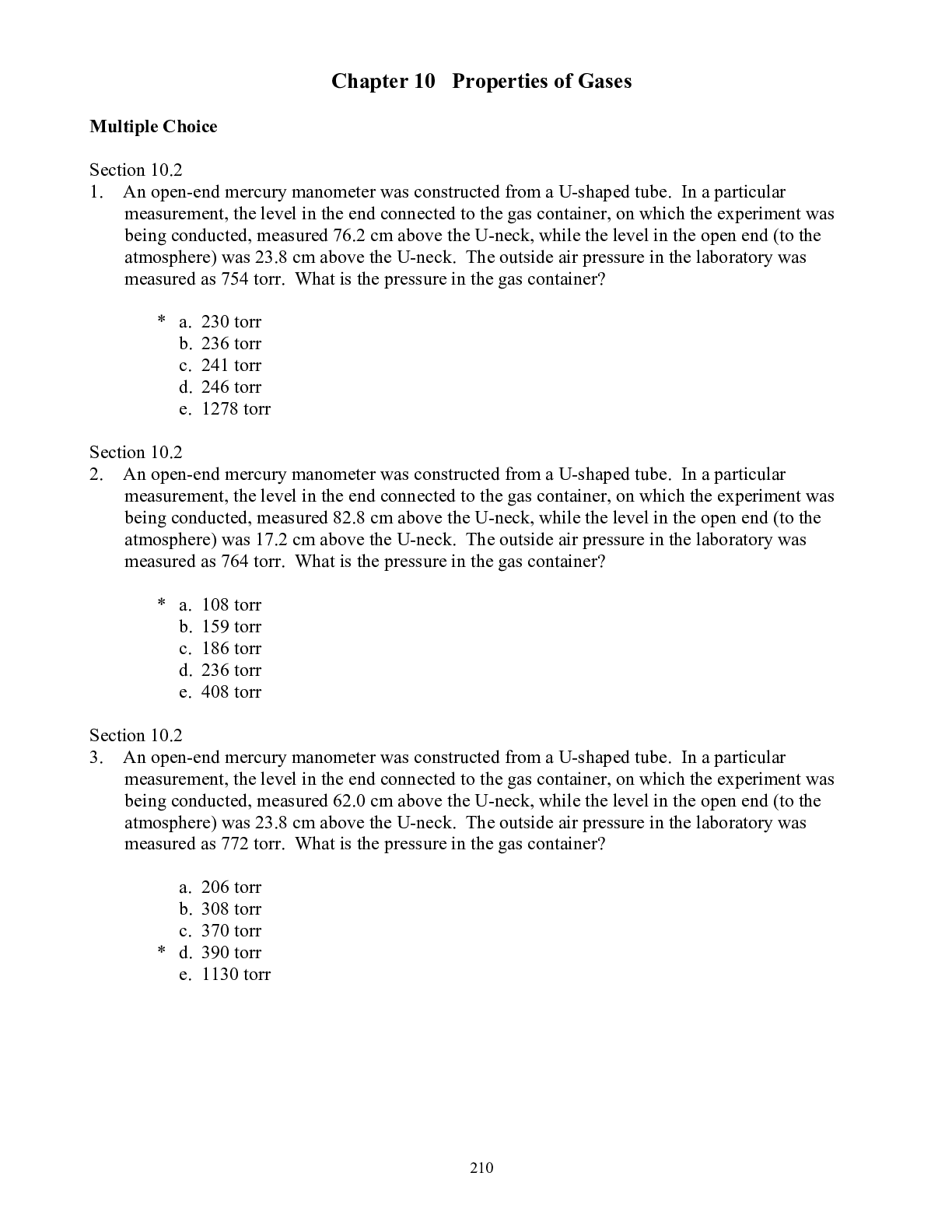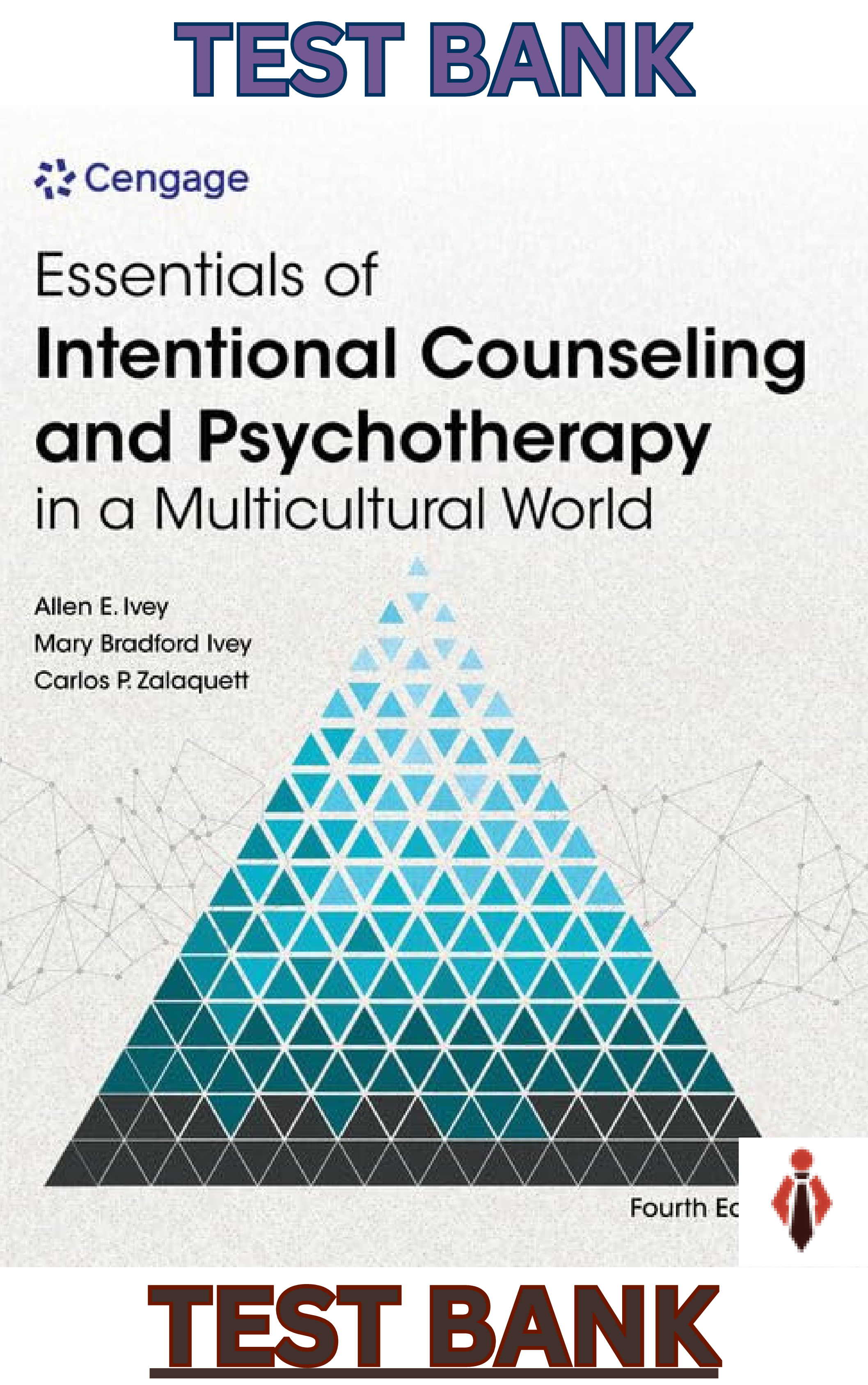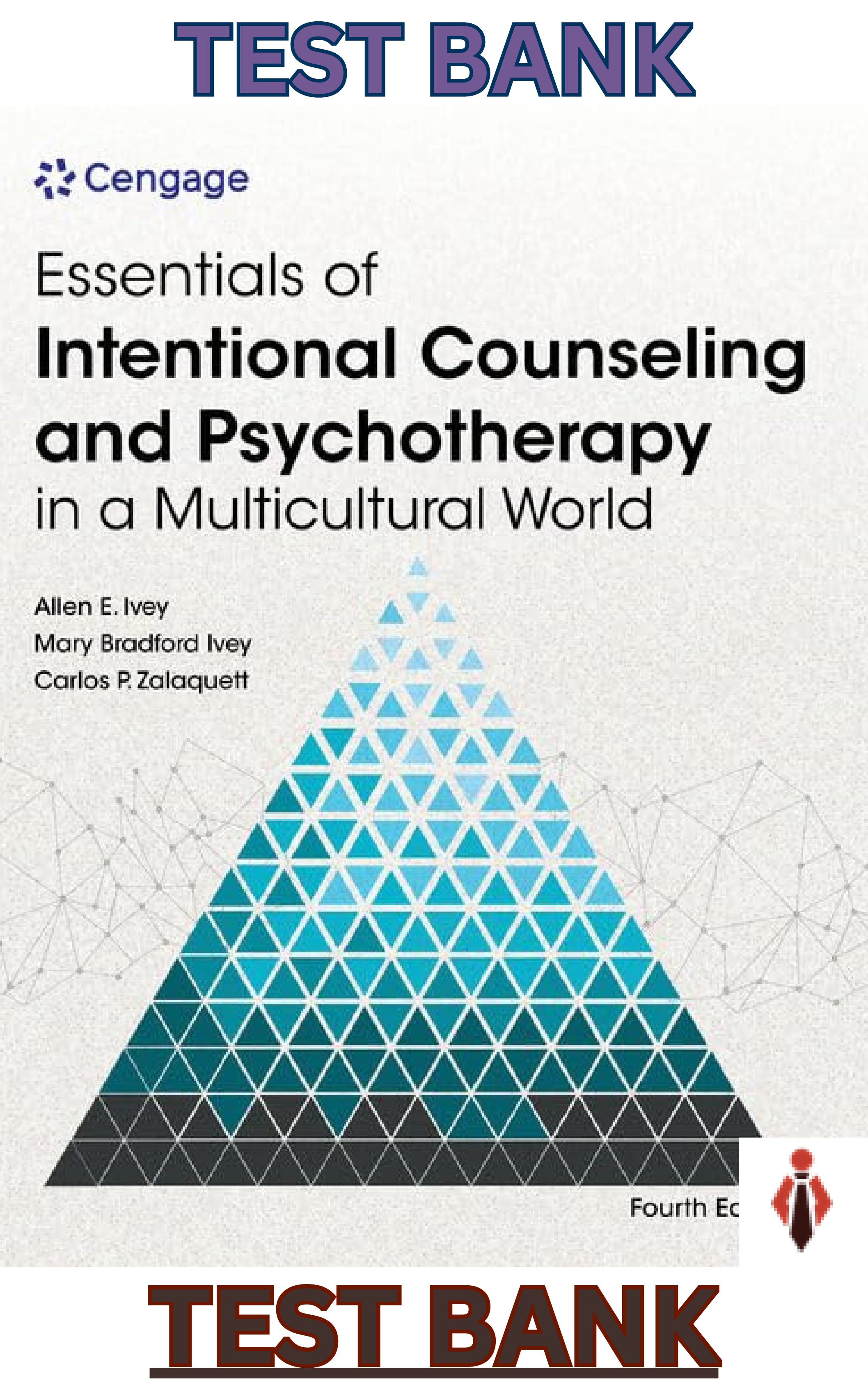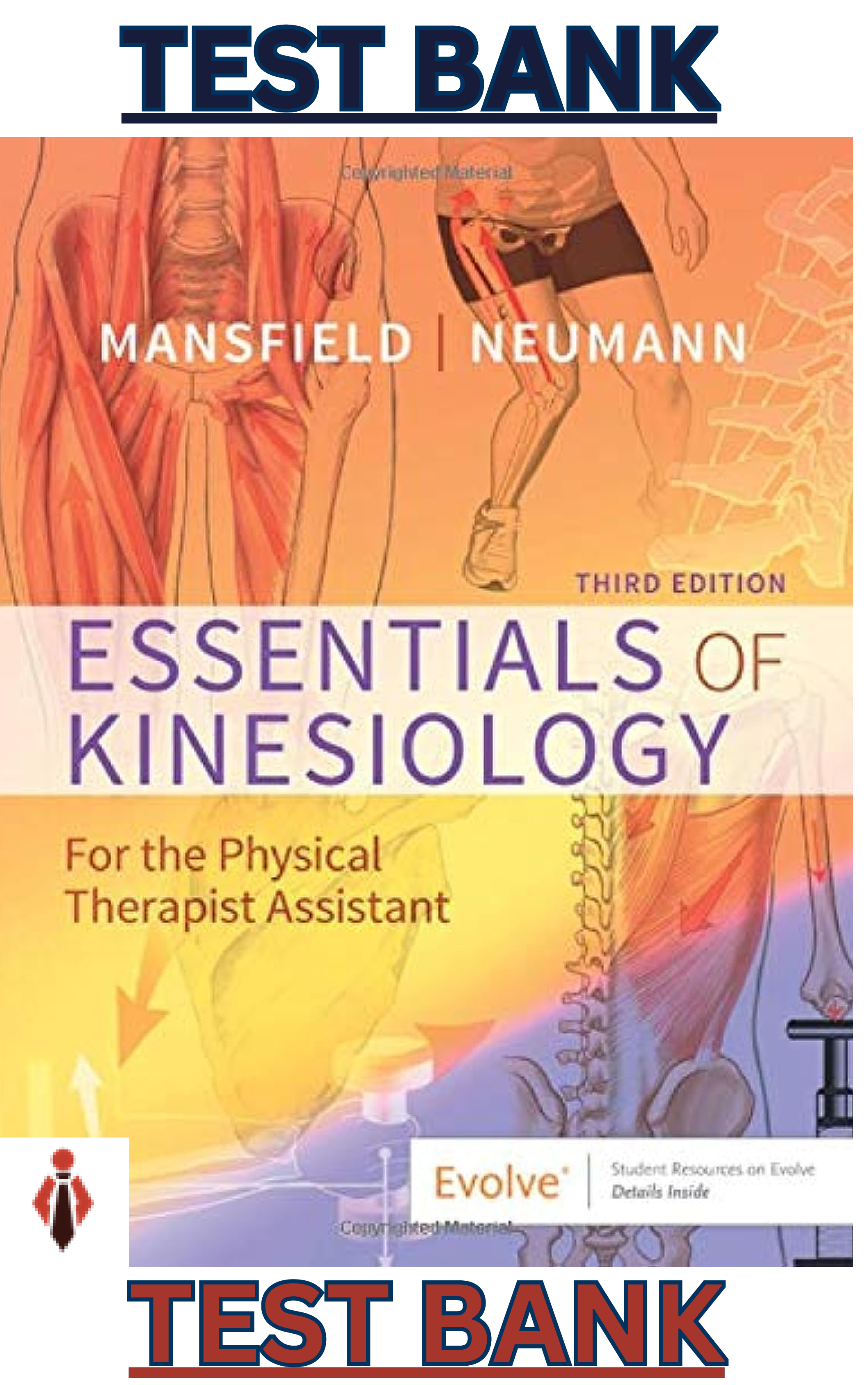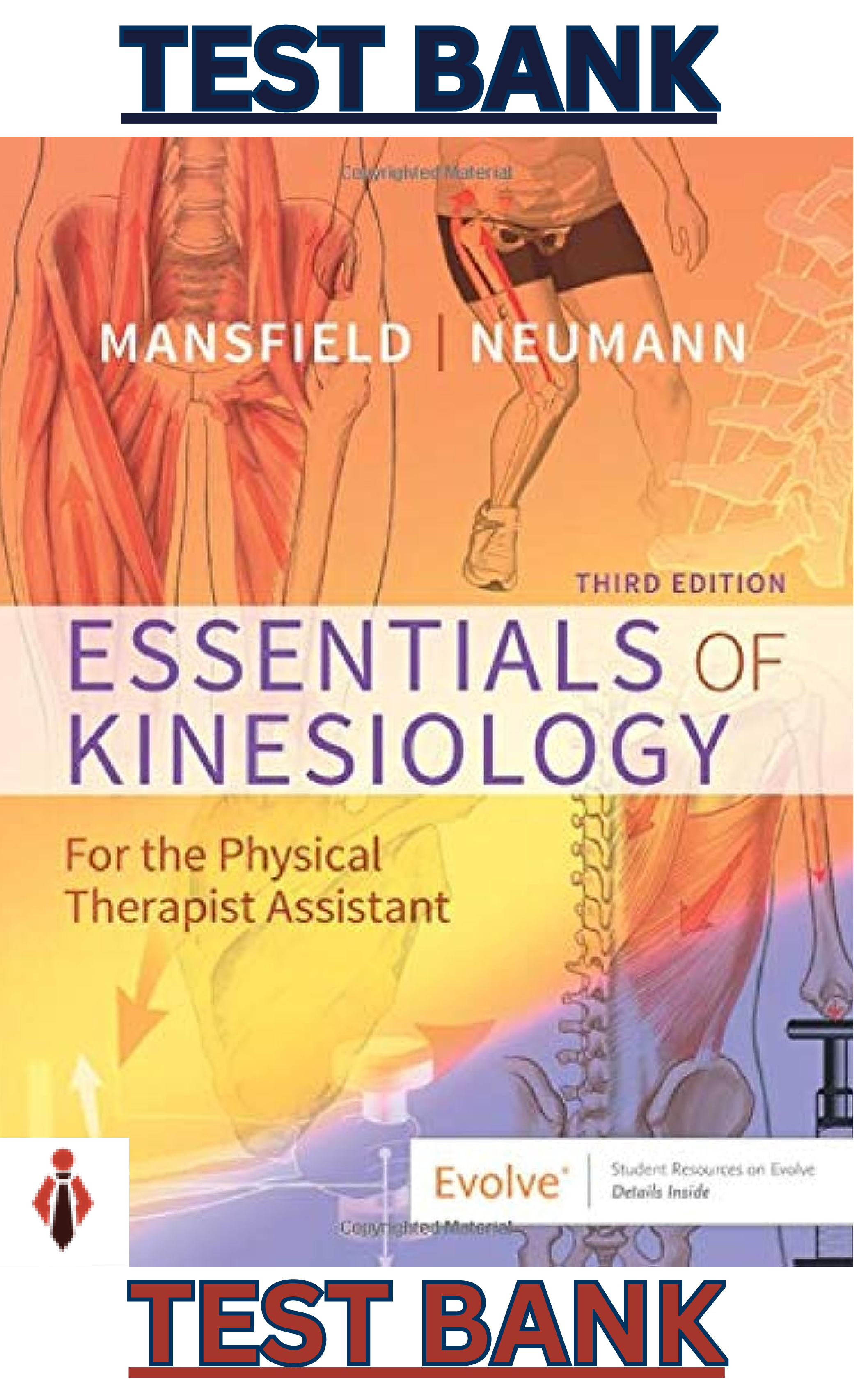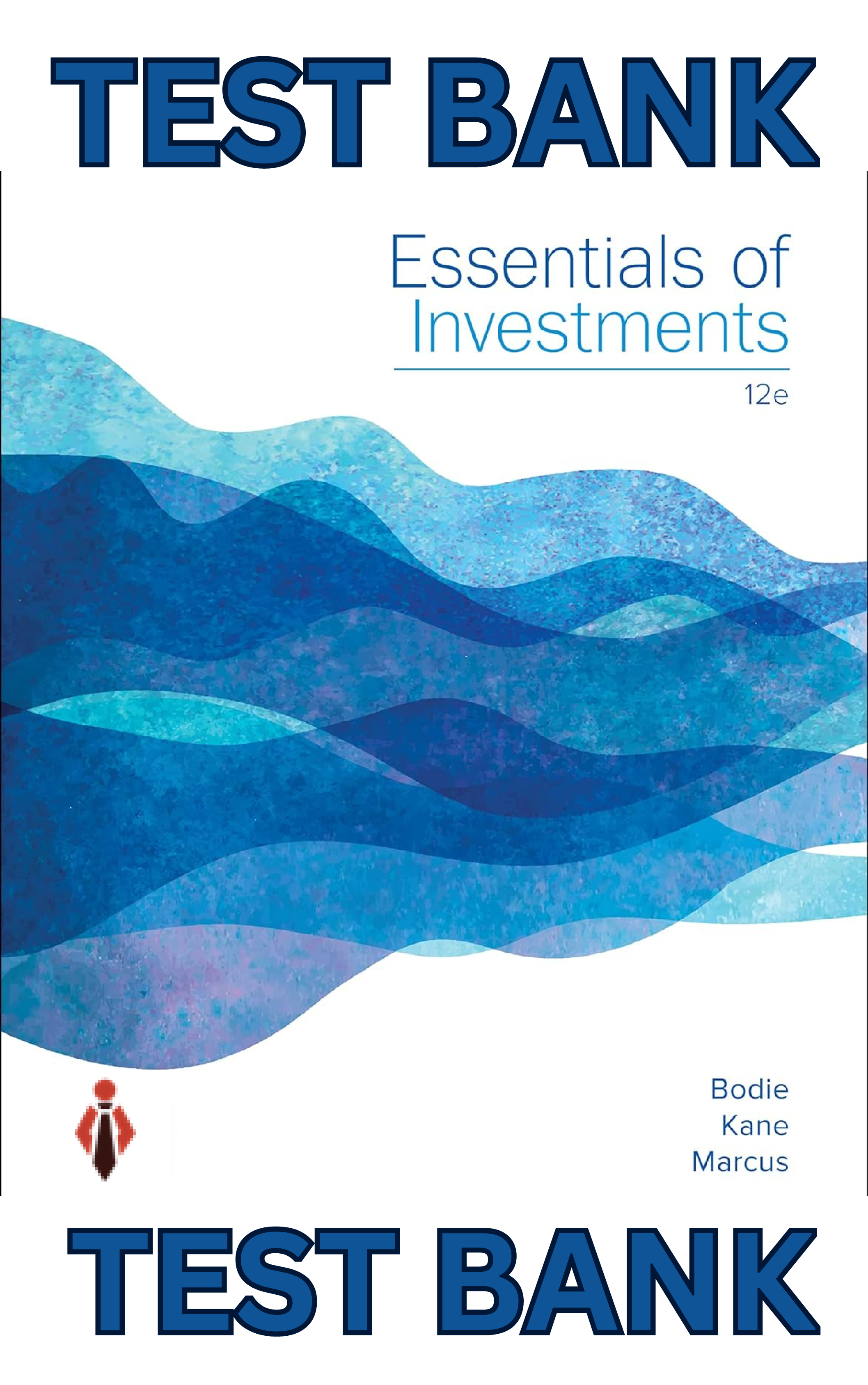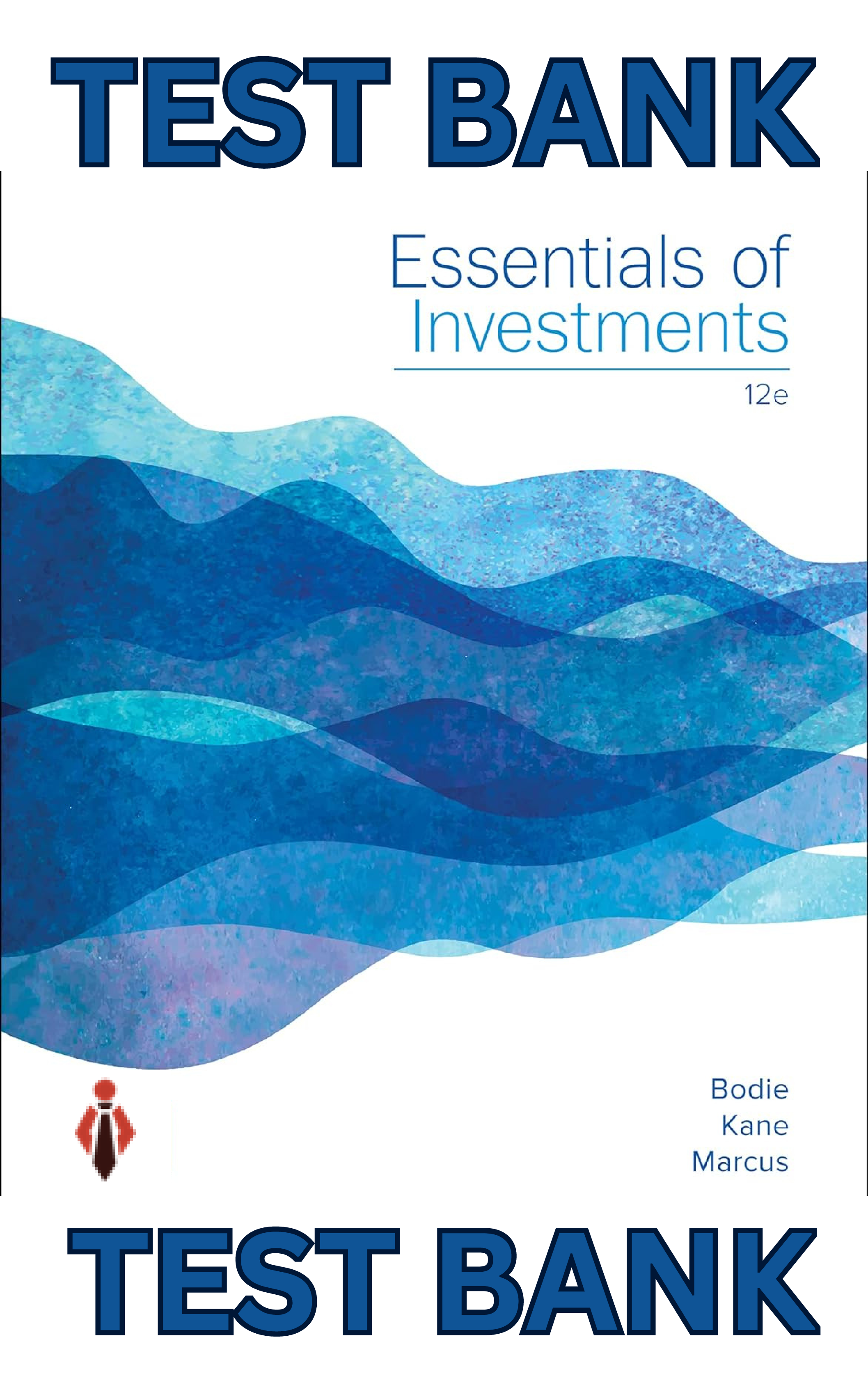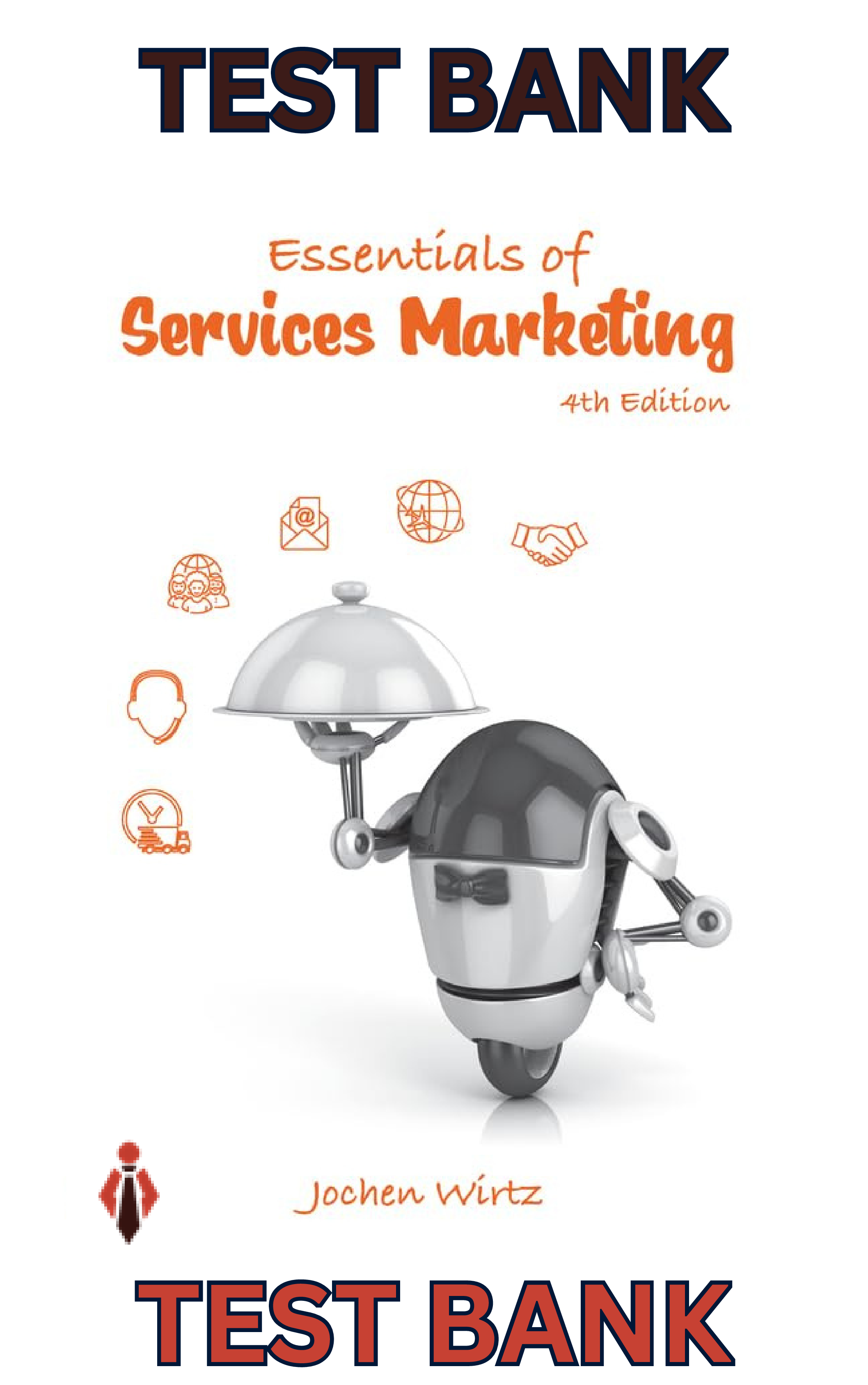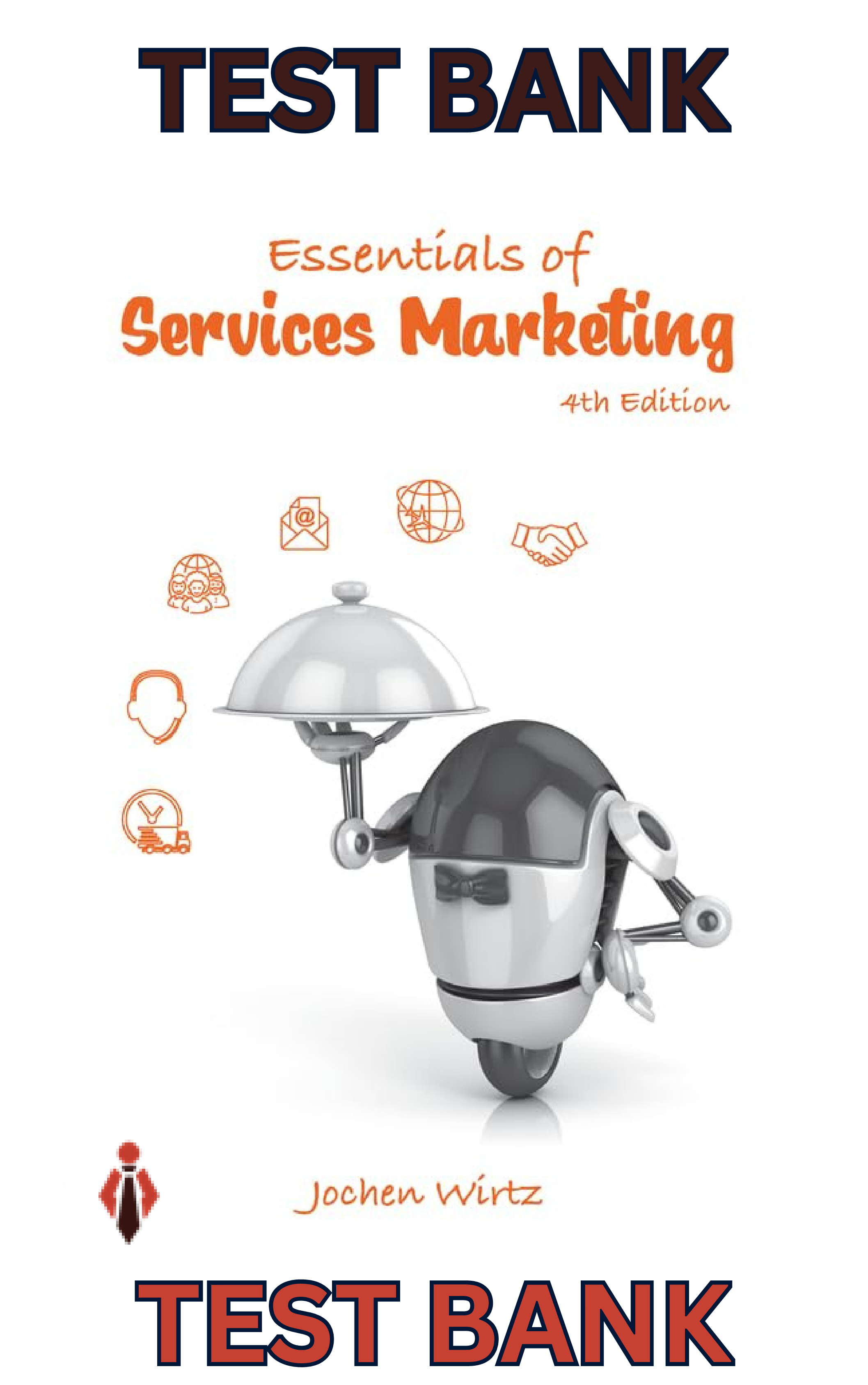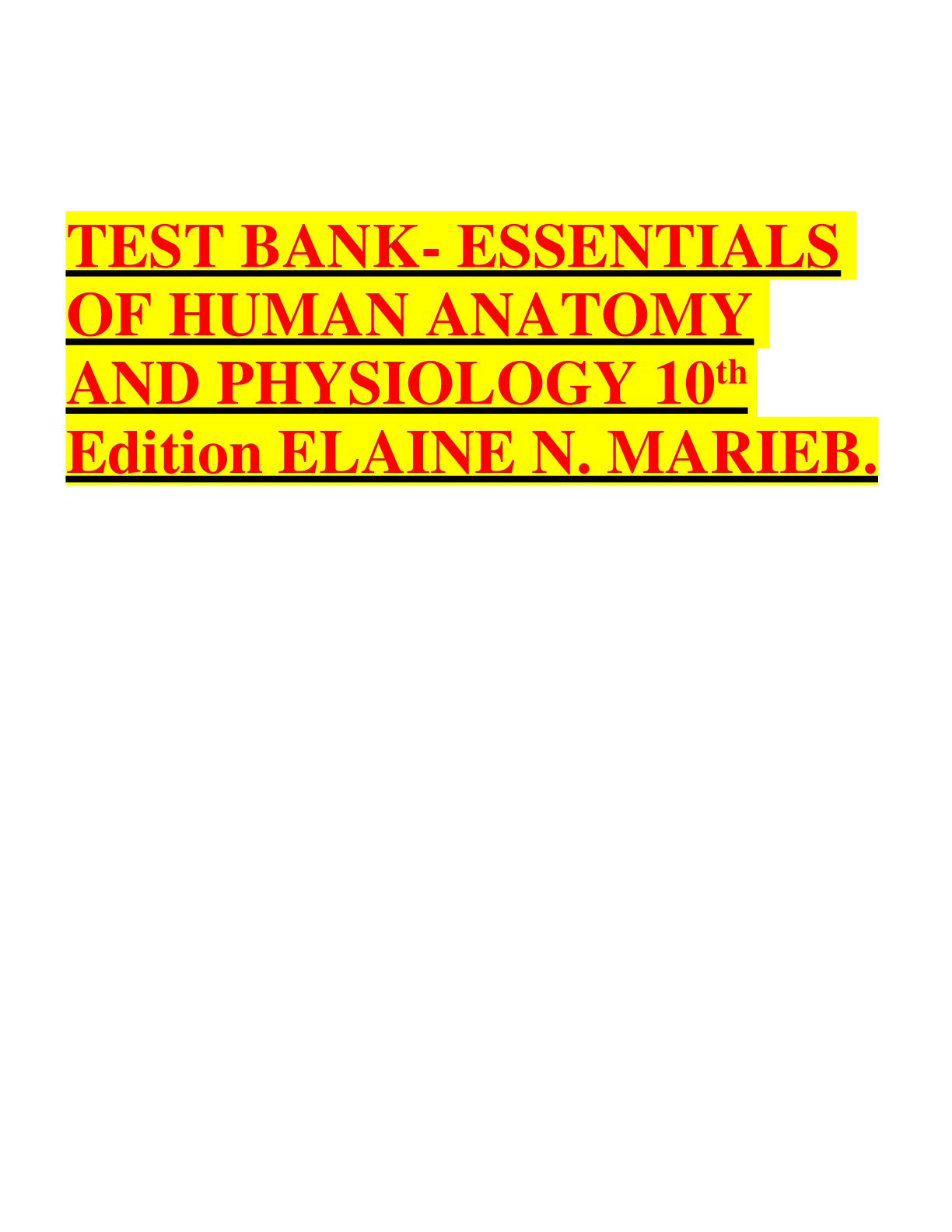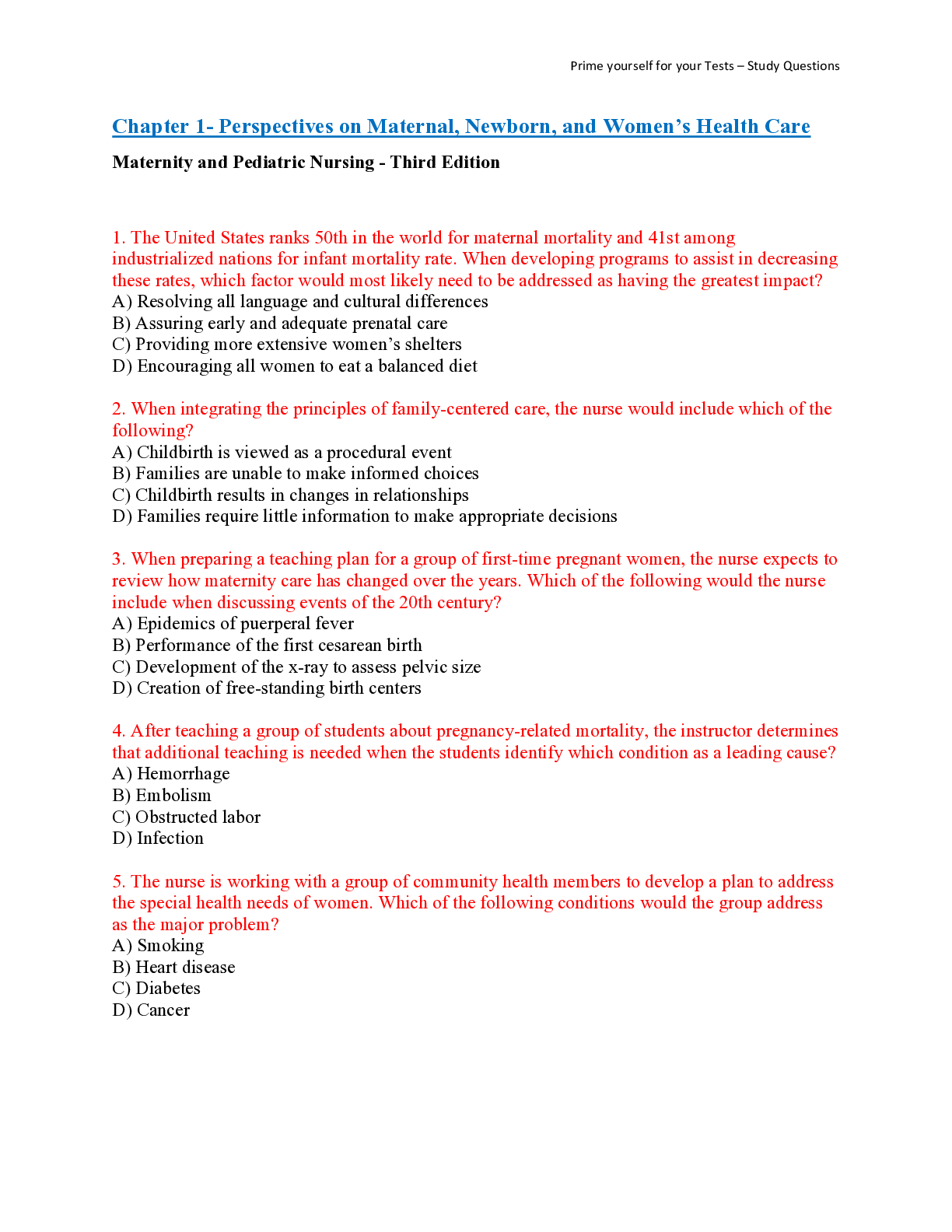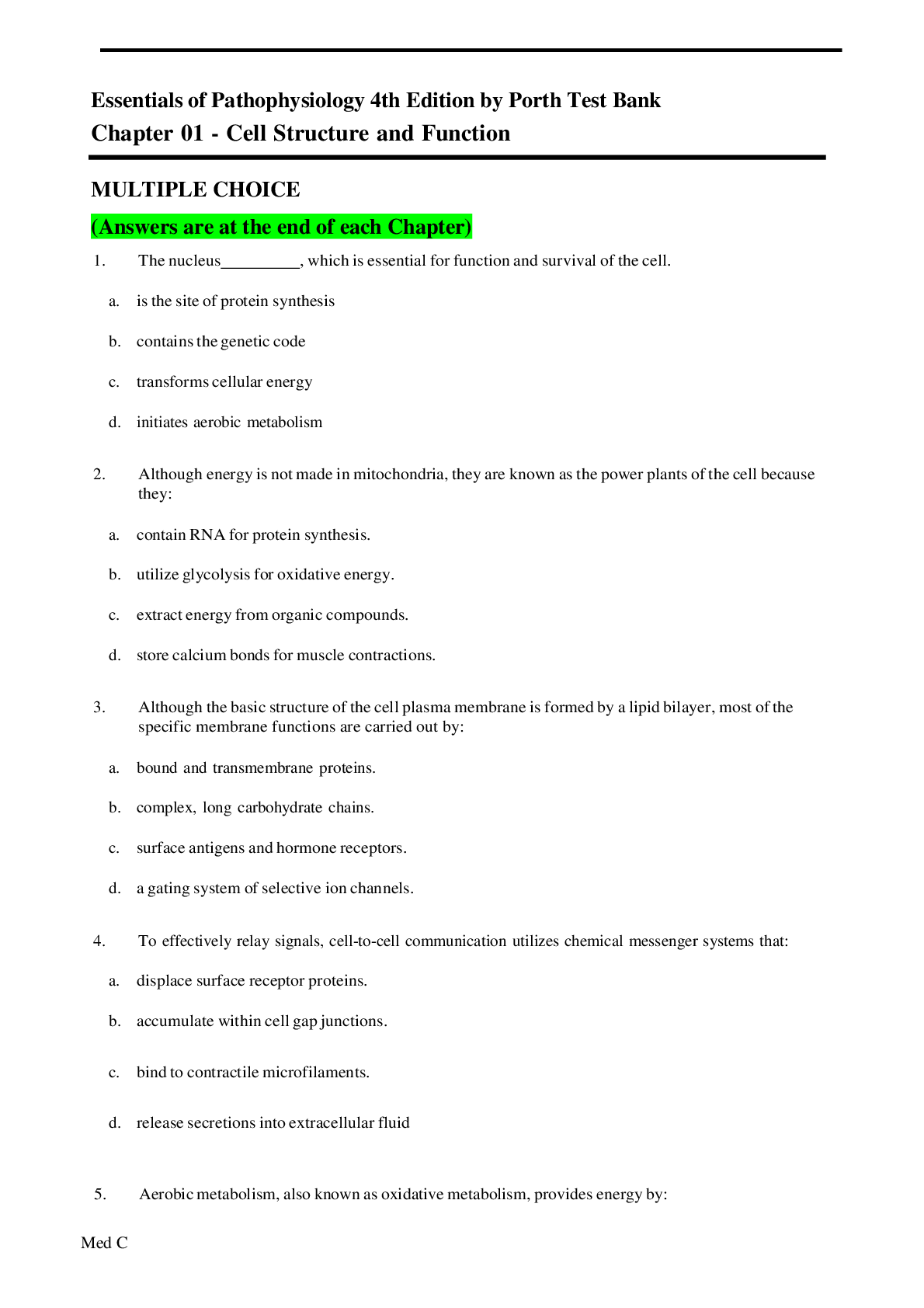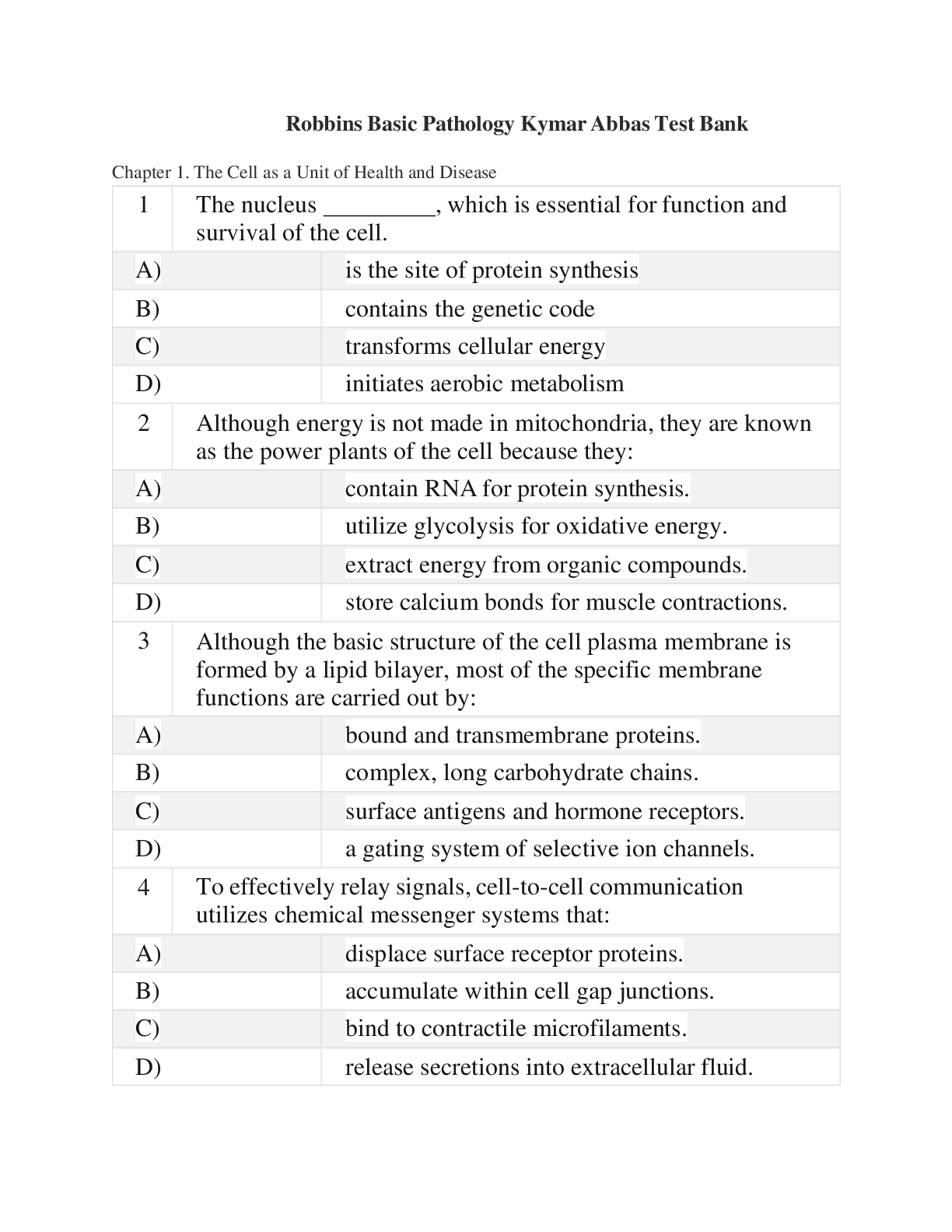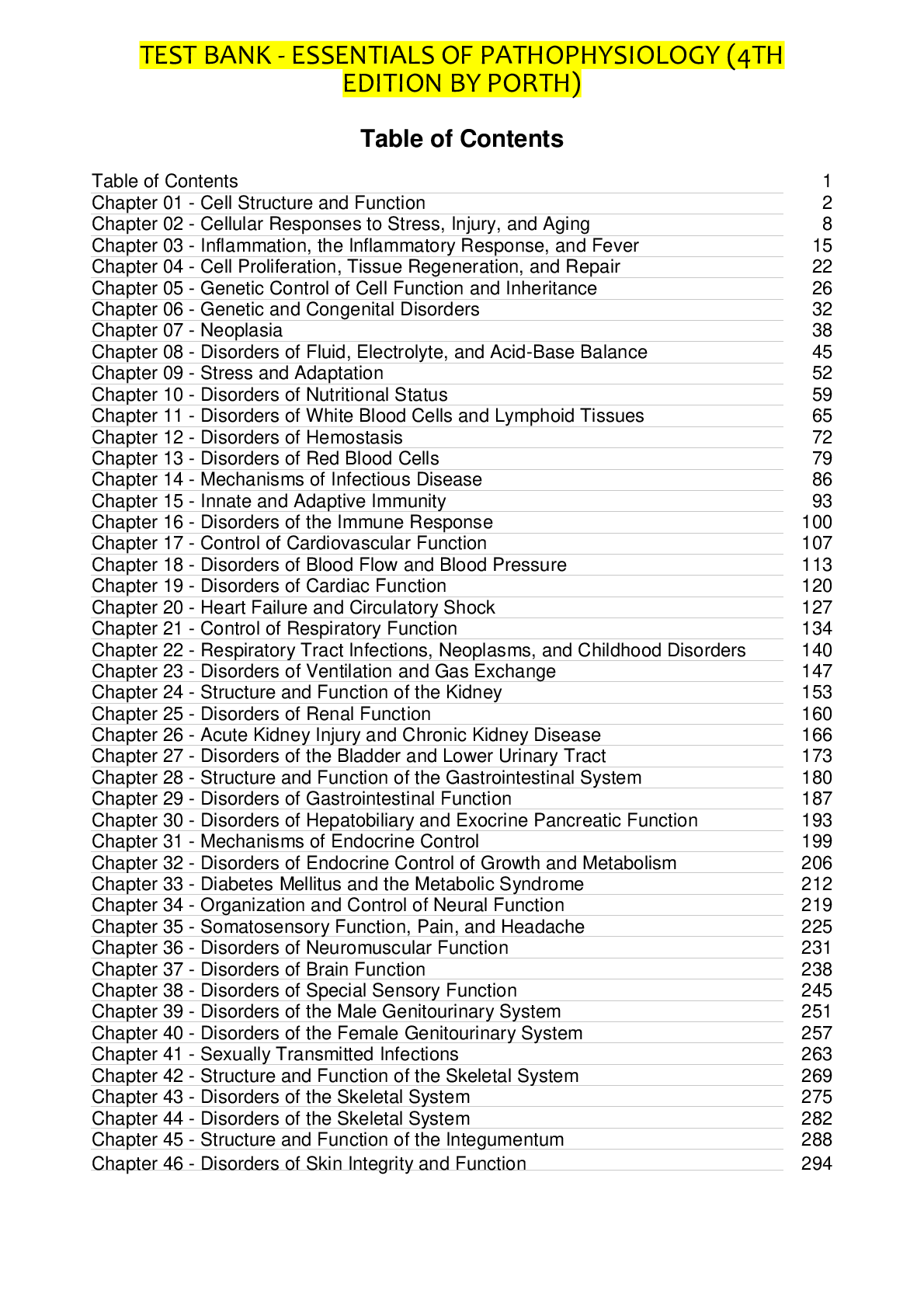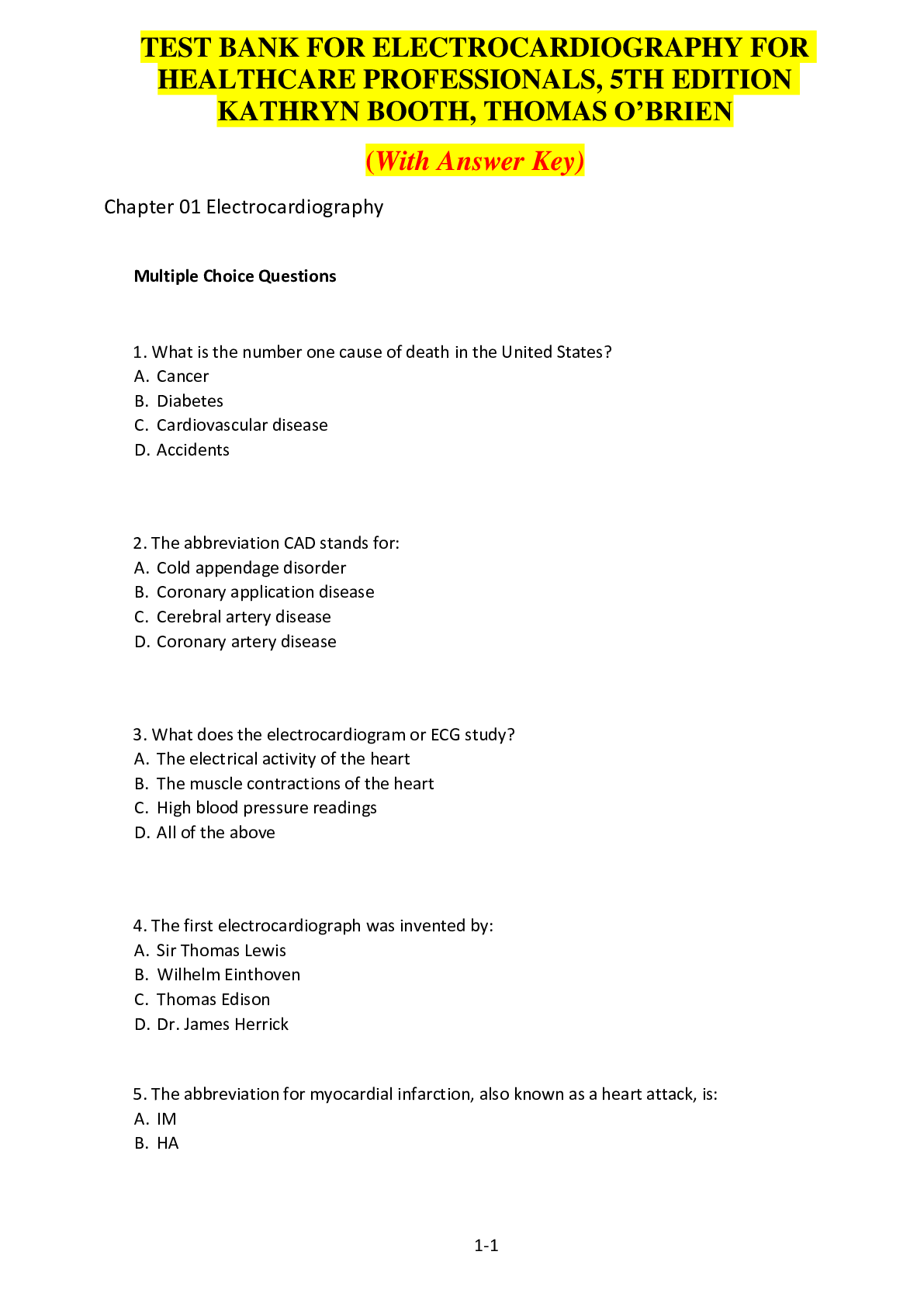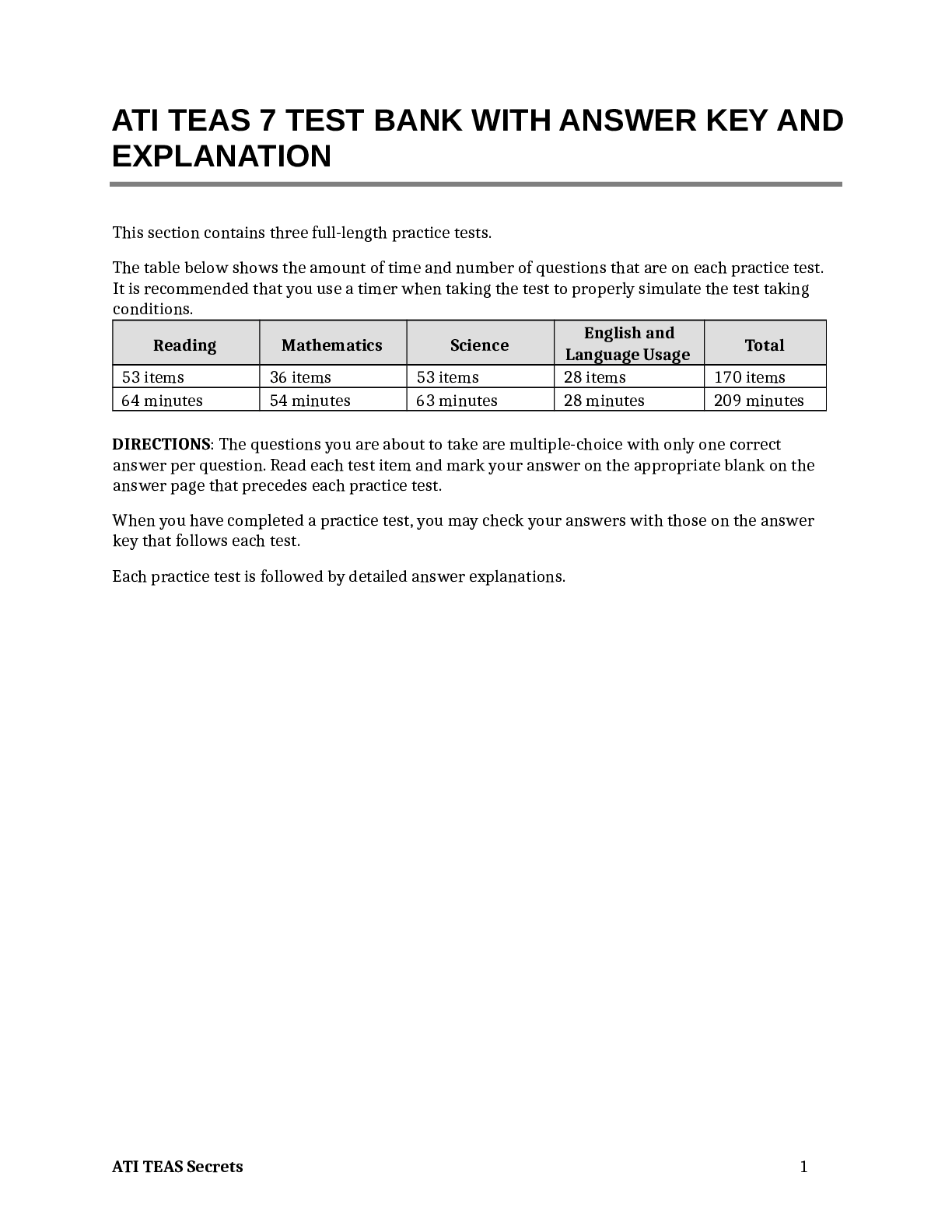Pathophysiology > TEST BANK > Test Bank - Essentials of Pathophysiology (4th Edition by Porth) ( with ANSWER KEY ) VERIFIED ANSWER (All)
Test Bank - Essentials of Pathophysiology (4th Edition by Porth) ( with ANSWER KEY ) VERIFIED ANSWERS, 100% CORRECT
Document Content and Description Below
Table of Contents Table of Contents Chapter 01 - Cell Structure and Function Chapter 02 - Cellular Responses to Stress, Injury, and Aging Chapter 03 - Inflammation, the Inflammatory Response, and ... Fever Chapter 04 - Cell Proliferation, Tissue Regeneration, and Repair Chapter 05 - Genetic Control of Cell Function and Inheritance Chapter 06 - Genetic and Congenital Disorders Chapter 07 - Neoplasia Chapter 08 - Disorders of Fluid, Electrolyte, and Acid-Base Balance Chapter 09 - Stress and Adaptation Chapter 10 - Disorders of Nutritional Status Chapter 11 - Disorders of White Blood Cells and Lymphoid Tissues Chapter 12 - Disorders of Hemostasis Chapter 13 - Disorders of Red Blood Cells Chapter 14 - Mechanisms of Infectious Disease Chapter 15 - Innate and Adaptive Immunity Chapter 16 - Disorders of the Immune Response Chapter 17 - Control of Cardiovascular Function Chapter 18 - Disorders of Blood Flow and Blood Pressure Chapter 19 - Disorders of Cardiac Function Chapter 20 - Heart Failure and Circulatory Shock Chapter 21 - Control of Respiratory Function Chapter 22 - Respiratory Tract Infections, Neoplasms, and Childhood Disorders Chapter 23 - Disorders of Ventilation and Gas Exchange Chapter 24 - Structure and Function of the Kidney Chapter 25 - Disorders of Renal Function Chapter 26 - Acute Kidney Injury and Chronic Kidney Disease Chapter 27 - Disorders of the Bladder and Lower Urinary Tract Chapter 28 - Structure and Function of the Gastrointestinal System Chapter 29 - Disorders of Gastrointestinal Function Chapter 30 - Disorders of Hepatobiliary and Exocrine Pancreatic Function Chapter 31 - Mechanisms of Endocrine Control Chapter 32 - Disorders of Endocrine Control of Growth and Metabolism Chapter 33 - Diabetes Mellitus and the Metabolic Syndrome Chapter 34 - Organization and Control of Neural Function Chapter 35 - Somatosensory Function, Pain, and Headache Chapter 36 - Disorders of Neuromuscular Function Chapter 37 - Disorders of Brain Function Chapter 38 - Disorders of Special Sensory Function Chapter 39 - Disorders of the Male Genitourinary System Chapter 40 - Disorders of the Female Genitourinary System Chapter 41 - Sexually Transmitted Infections Chapter 42 - Structure and Function of the Skeletal System Chapter 43 - Disorders of the Skeletal System Chapter 44 - Disorders of the Skeletal System Chapter 45 - Structure and Function of the Integumentum Chapter 46 - Disorders of Skin Integrity and Function Test Bank - Essentials of Pathophysiology (4th Edition by Porth) 1Chapter 01 - Cell Structure and Function 1. The nucleus _________, which is essential for function and survival of the cell. A) is the site of protein synthesis B) contains the genetic code C) transforms cellular energy D) initiates aerobic metabolism 2. Although energy is not made in mitochondria, they are known as the power plants of the cell because they: A) contain RNA for protein synthesis. B) utilize glycolysis for oxidative energy. C) extract energy from organic compounds. D) store calcium bonds for muscle contractions. 3. Although the basic structure of the cell plasma membrane is formed by a lipid bilayer, most of the specific membrane functions are carried out by: A) bound and transmembrane proteins. B) complex, long carbohydrate chains. C) surface antigens and hormone receptors. D) a gating system of selective ion channels. 4. To effectively relay signals, cell-to-cell communication utilizes chemical messenger systems that: A) displace surface receptor proteins. B) accumulate within cell gap junctions. C) bind to contractile microfilaments. Test Bank - Essentials of Pathophysiology (4th Edition by Porth) 2D) release secretions into extracellular fluid. 5. Aerobic metabolism, also known as oxidative metabolism, provides energy by: A) removing the phosphate bonds from ATP. B) combining hydrogen and oxygen to form water. C) activating pyruvate stored in the cytoplasm. D) breaking down glucose to form lactic acid. 6. Exocytosis, the reverse of endocytosis, is important in _______ into the extracellular fluid. A) Engulfing and ingesting fluid and proteins for transport B) Killing, degrading, and dissolving harmful microorganisms C) Removing cellular debris and releasing synthesized substances D) Destruction of particles by lysosomal enzymes for secretion 7. The process responsible for generating and conducting membrane potentials is: A) diffusion of current-carrying ions. B) millivoltage of electrical potential. C) polarization of charged particles. D) ion channel neurotransmission. 8. Epithelial tissues are classified according to the shape of the cells and the number of layers. Which of the following is a correctly matched description and type of epithelial tissue? A) Simple epithelium: cells in contact with intercellular matrix; some do not extend to surface B) Stratified epithelium: single layer of cells; all cells rest on basement membrane C) Glandular epithelium: arise from surface epithelia and underlying connective tissue D) Pseudostratified epithelium: multiple layers of cells; deepest layer rests on basement membrane Test Bank - Essentials of Pathophysiology (4th Edition by Porth) 39. Connective tissue contains fibroblasts that are responsible for: A) providing a fibrous framework for capillaries. B) synthesis of collagen, elastin, and reticular fibers. C) forming tendons and the fascia that covers muscles. D) filling spaces between tissues to keep organs in place. 10. Although all muscle tissue cells have some similarities, smooth muscle (also known as involuntary muscle) differs by: A) having dense bodies attached to actin filaments. B) containing sarcomeres between Z lines and M bands. C) having rapid contractions and abundant cross-striations. D) contracting in response to increased intracellular calcium. 11. Which of the following aspects of the function of the nucleus is performed by ribosomal RNA (rRNA)? A) Copying and carrying DNA instructions for protein synthesis B) Carrying amino acids to the site of protein synthesis C) Providing the site where protein synthesis occurs D) Regulating and controlling protein synthesis 12. Breakdown and removal of foreign substances and worn-out cell parts are performed by which of the following organelles? A) Lysosomes B) Golgi apparatus C) Ribosomes D) Endoplasmic reticulum (ER) 13. Impairment in the function of peroxisomes would result in: Test Bank - Essentials of Pathophysiology (4th Edition by Porth) 4A) inadequate sites for protein synthesis. B) an inability to transport cellular products across the cell membrane. C) insufficient energy production within a cell. D) accumulation of free radicals in the cytoplasm. 14. After several months of trying to conceive, a couple is undergoing fertility testing. Semen analysis indicates that the man’s sperm have decreased motility, a finding that is thought to underlie the couple’s inability to become pregnant. Which of the following cellular components may be defective within the man’s sperm? A) Ribosomes B) Microtubules C) Mitochondria D) Microfilaments 15. Which of the following statements is true of glycolysis? A) Glycolysis requires oxygen. B) Glycolysis occurs in cells without mitochondria. C) Glycolysis provides the majority of the body’s energy needs. D) Glycolysis produces energy, water, and carbon dioxide. 16. Which of the following membrane transport mechanisms requires the greatest amount of energy? A) Facilitated diffusion B) Passive transport C) Vesicular transport D) Simple diffusion 17. A male patient with a diagnosis of type 1 diabetes mellitus is experiencing hyperglycemia because he lacks sufficient insulin to increase the availability of glucose transporters in his cell membranes. Consequently, his cells lack intracellular glucose and it accumulates in his blood. Which of the Test Bank - Essentials of Pathophysiology (4th Edition by Porth) 5following processes would best allow glucose to cross his cell membranes? A) Facilitated diffusion B) Simple diffusion C) Secondary active transport D) Endocytosis 18. Which of the following statements is true of skeletal muscle cells? A) Skeletal muscle cells each have an apical, lateral, and basal surface. B) They are closely apposed and are joined by cell-to-cell adhesion molecules. C) Their basal surface is attached to a basement membrane. D) Skeletal muscle is multinucleated, lacking true cell boundaries. 19. Which of the following body tissues exhibits the highest rate of turnover and renewal? A) The squamous epithelial cells of the skin B) The connective tissue supporting blood vessels C) The skeletal muscle that facilitates movement D) The nervous tissue that constitutes the central nervous system 20. A patient with a pathophysiologic condition that affects the desmosomes is most likely to exhibit: A) impaired contraction of skeletal and smooth muscle. B) weakness of the collagen and elastin fibers in the extracellular space. C) impaired communication between neurons and effector organs. D) separation at the junctions between epithelial cells. Answer Key [Show More]
Last updated: 11 months ago
Preview 1 out of 301 pages
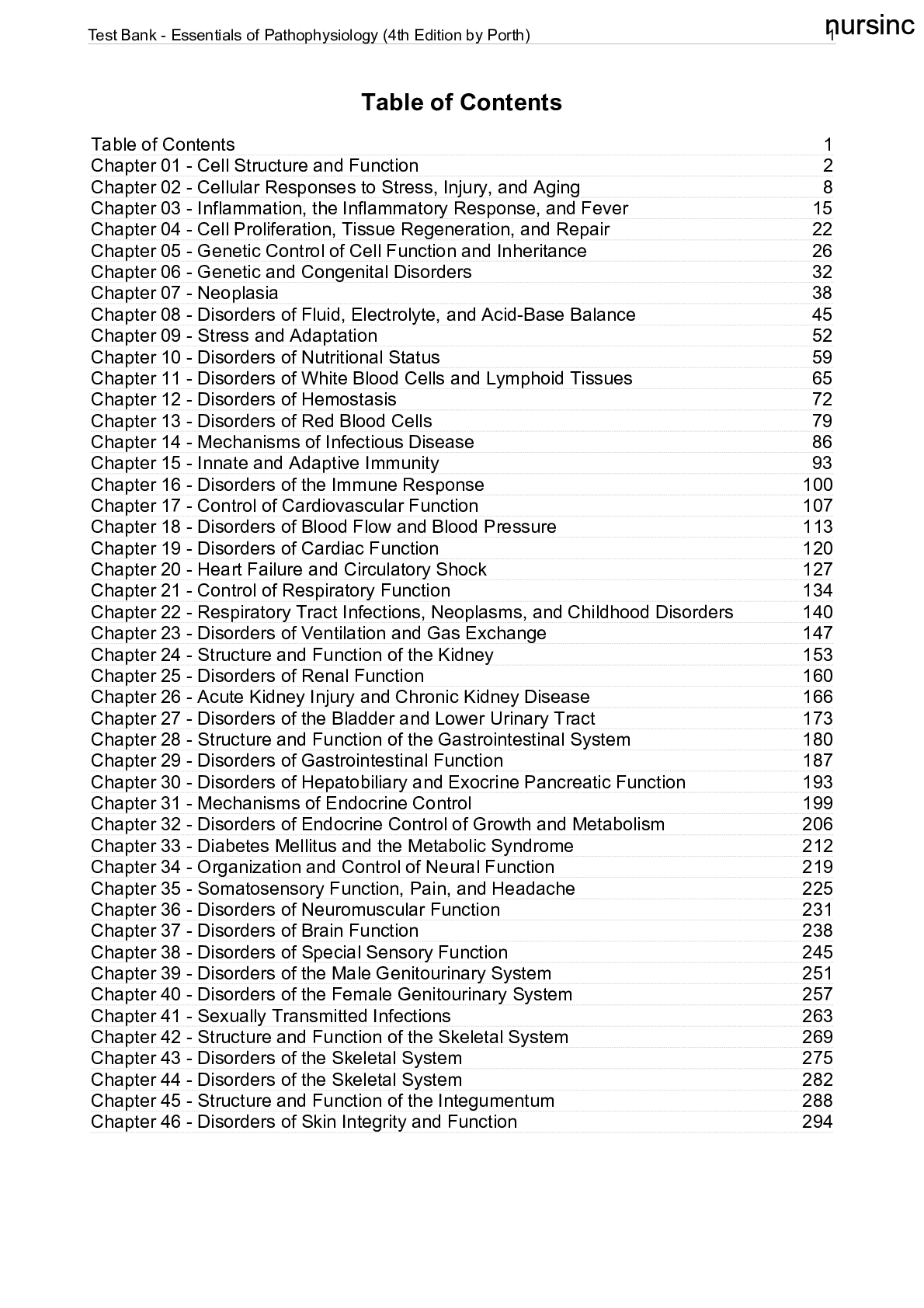
Reviews( 0 )
Document information
Connected school, study & course
About the document
Uploaded On
Jun 23, 2021
Number of pages
301
Written in
Additional information
This document has been written for:
Uploaded
Jun 23, 2021
Downloads
0
Views
49

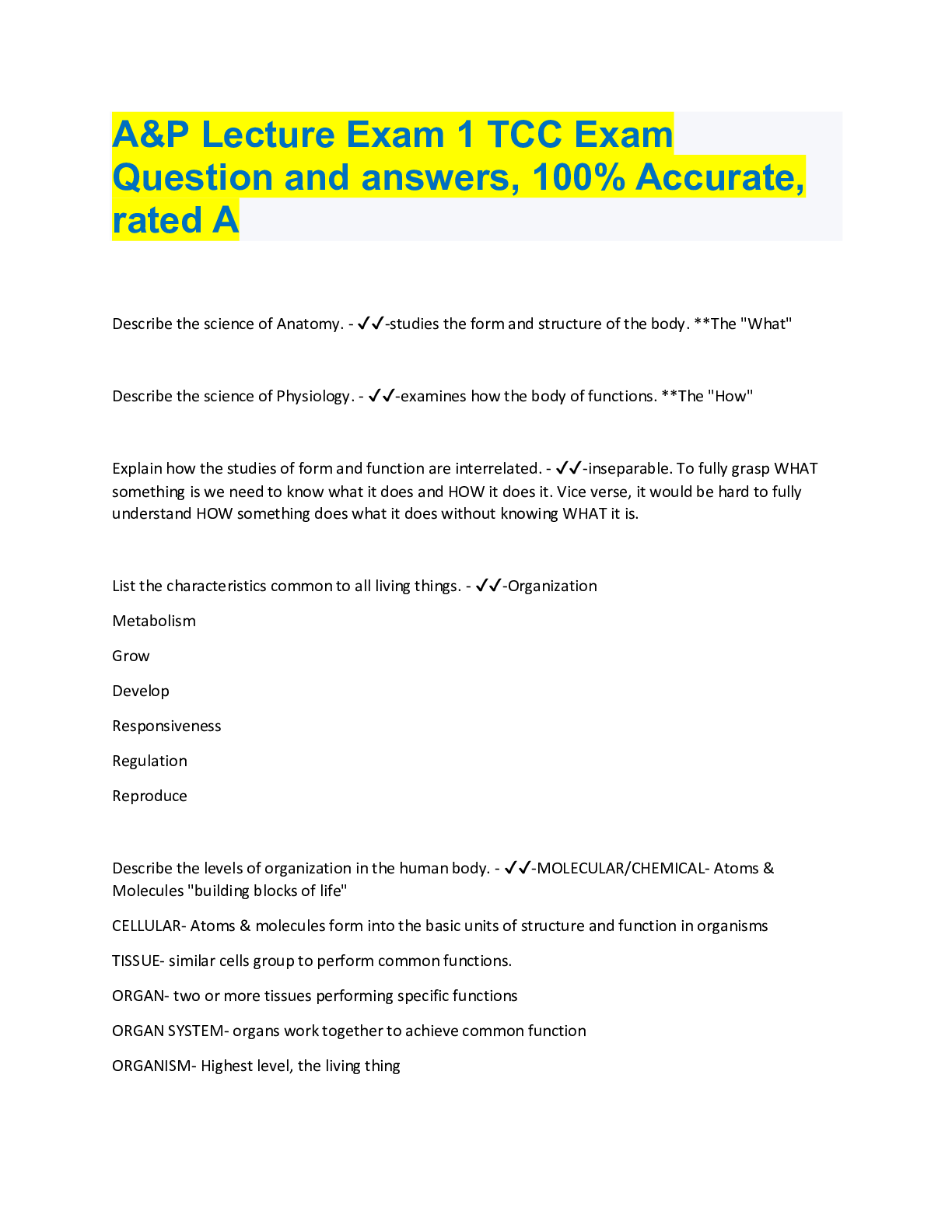
.png)


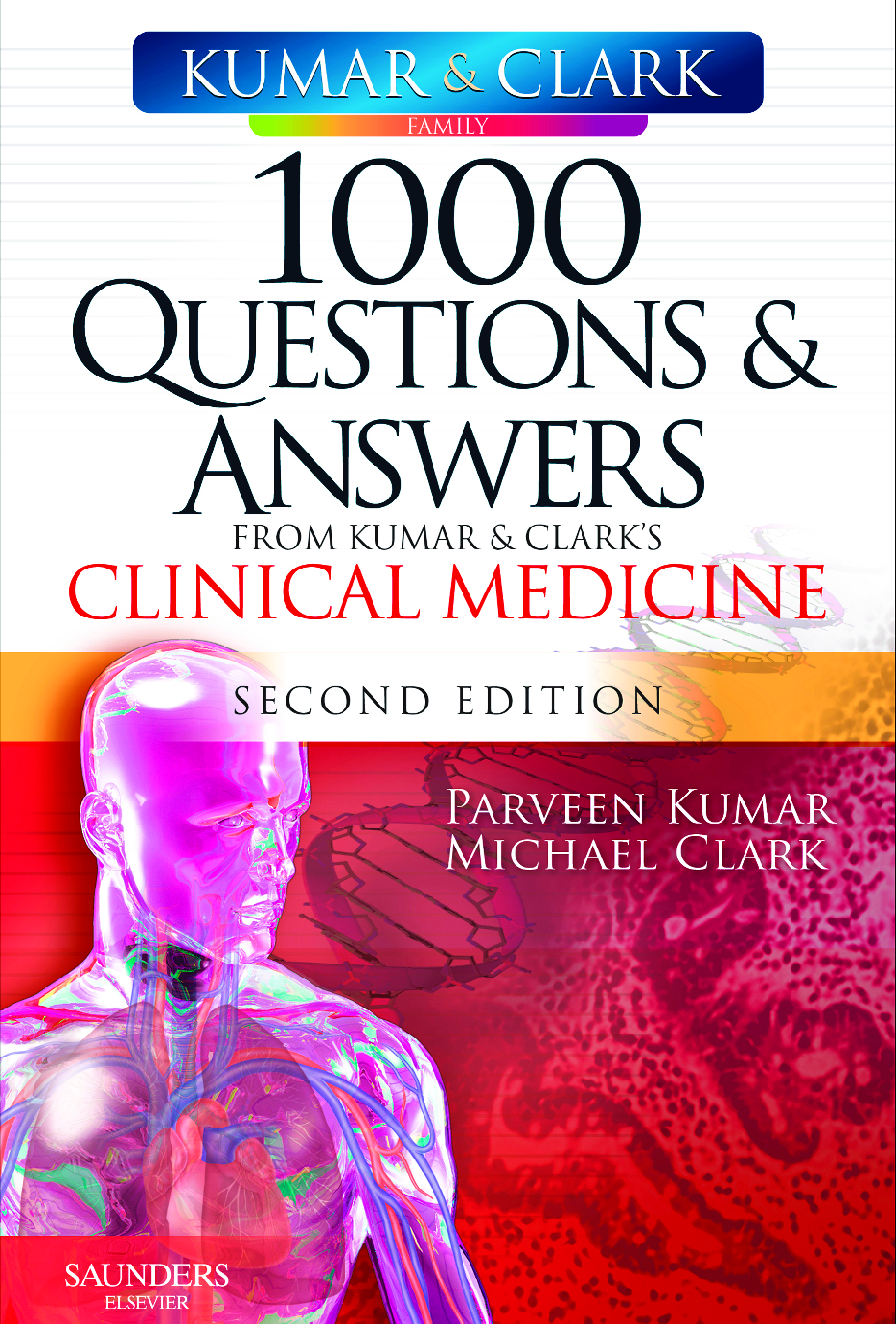
.png)
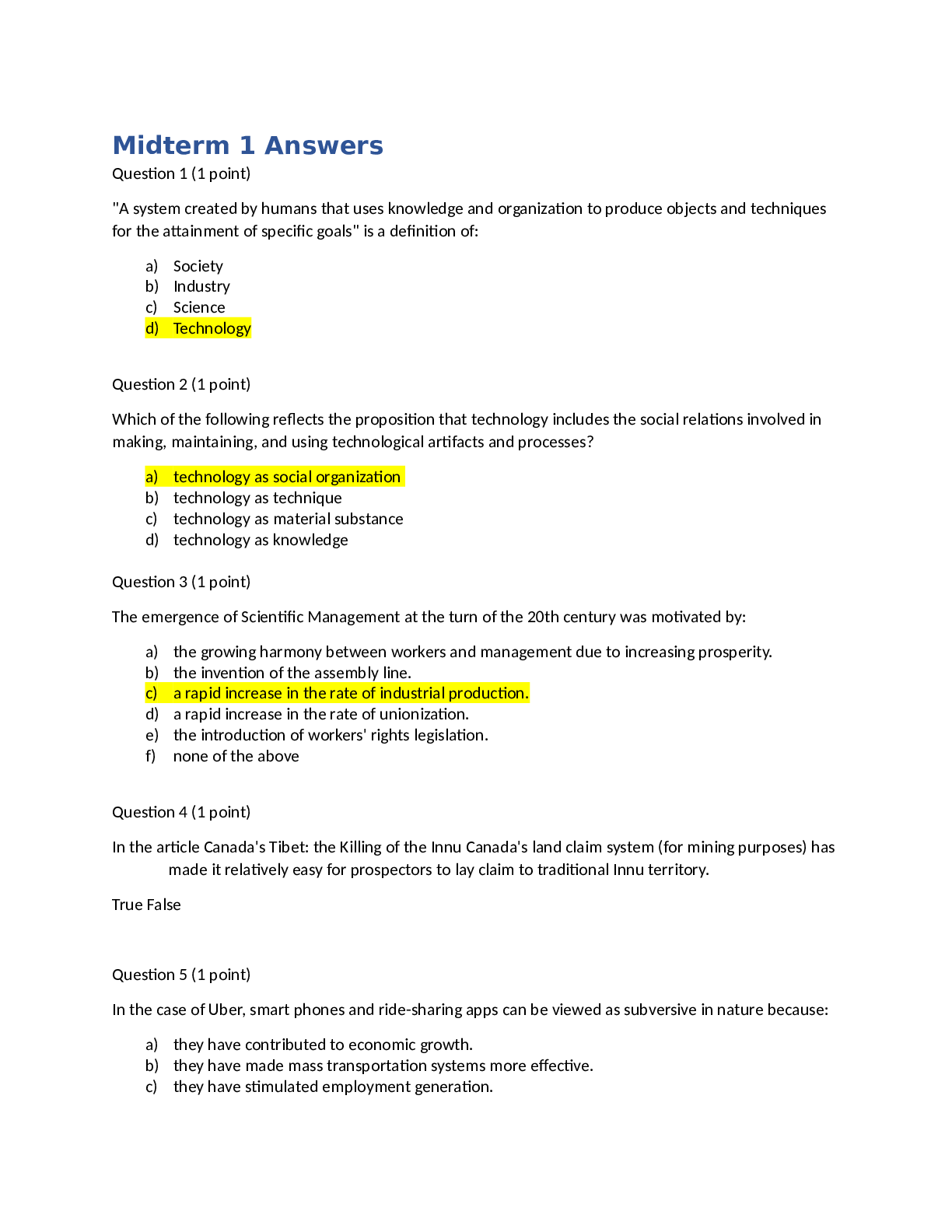
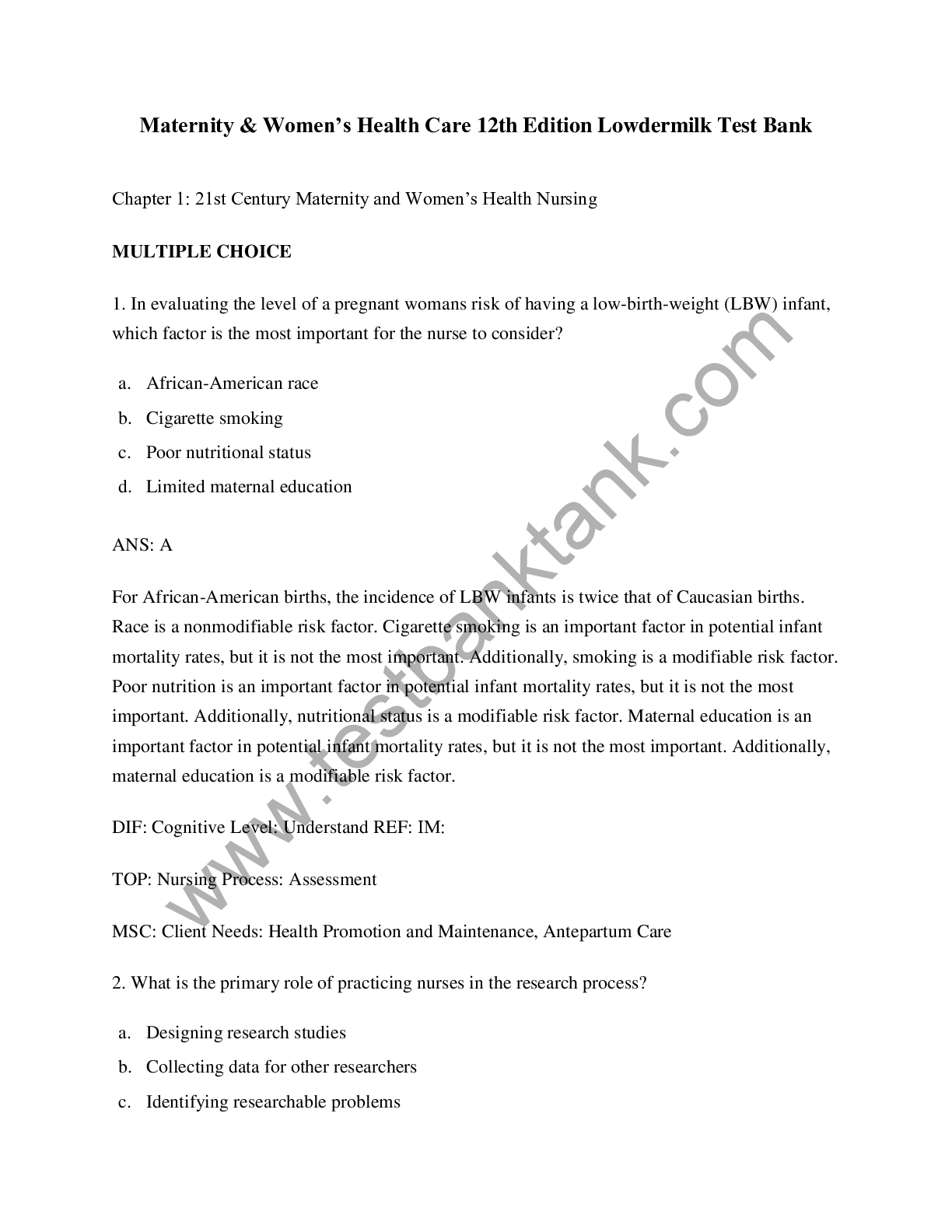

 David L.png)
.png)
